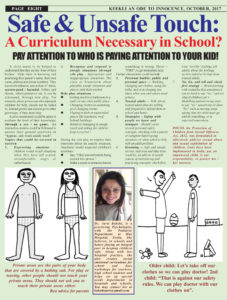 Dr. Aarti Bakshi, Psychologist, Pediatric Department, Max Hospital, Noida
Dr. Aarti Bakshi, Psychologist, Pediatric Department, Max Hospital, Noida
Saanvi, an 8-year-old, had accompanied her parents to an exhibition. She lost her way, and instead of losing her cool, found and approached, a guard, informed that she had to contact her father, rattled her father’s phone number, and asked her parents to come and collect her from the front busy door, where she waited patiently. She even refused to accompany the guard to try finding her parents, instead waited for them to pick her up. This is not a scene from a movie, instead a situation in the capital, of a child, whose school had implemented the ‘safe and unsafe touch’ sessions.
 In an idealistic plan, as every parent, I do wish, that I could accompany my children everywhere and ensure their safety. But having understood that although well meant, I might not be able to help them every moment, so empowering them is my way ahead to help themselves keep safe.
In an idealistic plan, as every parent, I do wish, that I could accompany my children everywhere and ensure their safety. But having understood that although well meant, I might not be able to help them every moment, so empowering them is my way ahead to help themselves keep safe.
Good and bad touch, safe and unsafe touch? Hmm, what’s the difference? Well, an unsafe touch may feel physically good, but destroys a child, emotionally and physically too. A child is defined as an individual until the age of 18, but in this article, I am addressing the safety concerns of 5-12 years old.
Two methods have appeared successful, in a school setting, firstly, integrating it in the school curriculum and secondly, repetitions, both from home and in a school class, according to the children’s ages.
The classroom faculty plays a major role, with showing comfort in implementing the session. Many a times, the session is taken as a taboo, and so teachers are reluctant to implement it. A school counsellor, could lead it and then the teacher could repeat it. Parents should be informed about the session through an email or circular, so that they are prepared to answer the questions of their children along with understand what is expected of them.
Expected outcome of the sessions is that the children would be able to identify and differentiate between safe and unsafe touch; recognize and respond to unsafe situations; personal safety; seek assistance effectively; know their trusted adults and recognize and establish safe areas, including home and outings.
A sex offender continually seeks ACCESS AND PRIVACY with their intended target as part of their manipulation and grooming process. In addition, there are often other red flag warning signs and behaviours to indicate that someone may not be a safe choice around your child. Use common sense, monitor certain relationships that others have with your child, particularly if there are indicators that give YOU an “Uh-Oh Feeling” or just don’t seem right.
PAY ATTENTION TO WHO IS PAYING ATTENTION TO YOUR KID!
A child needs to be helped to understand that they are the ‘boss of their bodies’. Help them in knowing and practicing their parent’s name, their own name, address and phone numbers. They have to be talked to, and realize of ‘tricks, secrets-good / harmful, bribes and threats, which predators use. It can be discussed, through role play. For example, about grown-ups who approach children for help, should not be talked to, instead grown-ups should go to other grownups, if they need help.
A prior assessment could be taken to evaluate the level of their knowledge; through a yes / no game. An interactive session could be followed to answer their general questions on “hygiene, safe touch unsafe touch”.
Topics that could be covered in session
- Expressing emotions – children would recall situations when they have left scared, uncomfortable, angry or embarrassed.
- Recognize and respond to unsafe situations through role play – Appropriate and inappropriate situations. The class to brainstorm about plausible unsafe situations and places, with their teacher.
Role play situations —
- Getting stuck in a bathroom in a mall / or any other public place.
- Changing clothes in swimming pool changing rooms.
- Playing in dark or unattended places like basement, roof, behind buildings.
- Relatives indulging in unsafe touch and asking the child to keep it a secret !
During the role play to express their emotions about an unsafe situation, (teachers) model expected children’s reactions:
- Say, “I feel uncomfortable being around this person.”
- Make a scene so someone knows something is wrong. Shout — “FIRE”, to get immediate help.
Further discussions could include:
- Personal bubble; public and personal space — Bathing, changing our clothes, using the toilet, and even sleeping are times when you and others need privacy.
- Trusted adults — Talk about trusted adults that are willing and prepared to defend them in school and home.
- Strategies – Safety with people we know and strangers: Should cover several personal safety concepts, checking with a parent or caregiver before going anywhere or when asked to help with an adult problem;
- Grooming — Safe and unsafe secrets, real trust and fake trust could be, an add on. It would consist of introducing and practicing concepts: check first, trust “terrible” feelings, tell adults about the feelings, secrets asked to be kept from trusted adults.
- No, Go, and tell and check first strategy — Brainstorming with examples that sometimes it can be hard to say “no,” and it’s okay if children can’t. Modelling and mirroring ways to say “no” assertively or show “No” such as moving away, saying that the child must go and do something, or is expected somewhere.
POCSO, the Protection of Children from Sexual Offences Act, 2012, was formulated to effectively address sexual abuse and sexual exploitation of children. Laws have been implemented in India, yet, an empowered child, is our responsibility, to protect his / her interest.
(Dr. Aarti Bakshi, is a practicing Psychologist, with the Paediatric Department, at Max Hospital, Noida. She believes, in schools and homes playing an integral part in keeping children safe. Along with her hospital practice, she also creates social emotional curriculums for school and does workshops for teachers, high school students and helps set up special needs departments in hospitals and schools)





